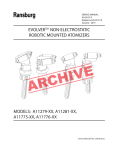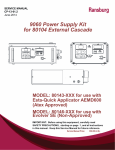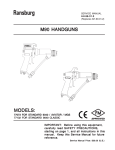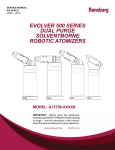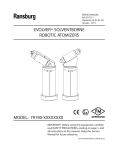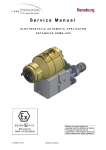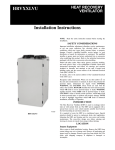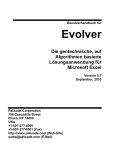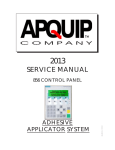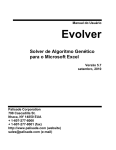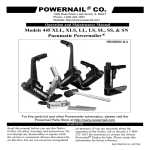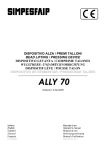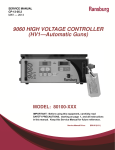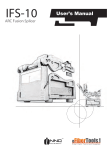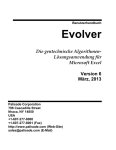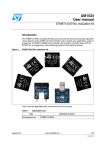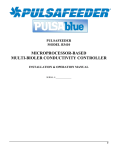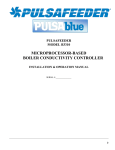Download Evolver SE Manual 2.0
Transcript
PRODUCT MANUAL AA-09-01 Evolver SE Robotic Atomizer MODEL: A12455-XXXXXXXX IMPORTANT: Before using this equipment, carefully read SAFETY PRECAUTIONS, starting on page 1, and all instructions in this manual. Keep this Service Manual for future reference. Product Manual Price: $50.00 2 CONTENTS Section 1: SAFETY 5-9 Safety Precautions Hazards / Safeguards Section 2: INTRODUCTION 10-12 Evolver SE Specifications Features Evolver SE Applicator Selection Guide Section 3: INSTALLATION 13-18 Overview High Voltage Cable and Tubing (installation) High Voltage Cable and Tubing (removal) Changing Gun Head Angle Paint Mate Robot Non-Hollow Wrist / Hollow Wrist Conversion ITW Ransburg REA-III / Evolver SE Conversion Bracket Evolver SE to 9040 Power Supply Connections Evolver SE to 9050 Power Supply Connections Evolver SE to Voltage Master-2 Power Supply Connections Section 4: OPERATION 19-22 Overview General Guidelines Gun Controls Section 5: MAINTENANCE 23-59 Overview Routine Maintenance Schedule Applicator Cleaning Service Overview Proper Tools AA-09-01 : Evolver SE 3 Spray Head Assembly (removal) Spray Head Disassembly Spray Head Reassembly Spray Head Assembly (installation) Section 6: APPENDIX 60-77 Tool Center Point Drawings Evolver SE Complete Assembly Parts Identification Spray Head Assembly Parts Identification Manifold Assembly Parts Identification High Voltage Cable Selection Part Identification Recommended Spare Parts Repair Kits / Lubricants and Sealers Troubleshooting Guide Warranty Policies AA-09-01 : Evolver SE 4 Section 1: SAFETY Before operating, maintaining or servicing any ITW Ransburg electrostatic coating system, read and understand all of the technical and safety literature for your ITW Ransburg products. This manual contains information that is important for you to know and understand. This information relates to USER SAFETY and PREVENTING EQUIPMENT PROBLEMS. To help you recognize this information, we use the following symbols: CAUTION - states information that tells how to prevent damage to equipment or how to avoid a situation that might cause minor injury. WARNING - states information to alert you to a situation that might cause serious injury if instructions are not followed. While this manual lists standard specifications and service procedures, some minor deviations may be found between the literature and your equipment. Differences in local codes and plant requirements, material delivery requirements, etc., make such variations inevitable. Compare this manual with your system installation drawings and appropriate ITW Ransburg equipment manuals to reconcile such differences. Careful study and continued use of this manual will provide a better understanding of the equipment and process, resulting in more efficient operation, longer trouble-free service and faster, easier troubleshooting. If you do not have the manuals and safety literature for your Ransburg system, contact your local ITW Ransburg representative or ITW Ransburg. WARNING • The user MUST read and be familiar with the Safety Section in this manual and the ITW Ransburg safety literature therein identified. • This manual MUST be read and thoroughly understood by ALL personnel who operate , clean or maintain this equipment! Special care should be taken to ensure that the WARNINGS and safety requirements for operating and servicing the equipment are followed. The user should be aware of and adhere to ALL local building and fire codes and ordinances as well as NFPA 33 SAFETY STANDARD, 2009 EDITION, prior to installing, operating, and/or servicing this equipment. • The hazards shown on the following pages may occur during normal use of this equipment. Please read the hazard chart beginning on page 6. AA-09-01 : Evolver SE 5 AREA Spray Area HAZARD SAFEGUARDS Fire Hazard Follow These Guidelines Improper or inadequate operation and maintenance procedures will cause a fire hazard. Fire extinguishing equipment must be present in the spray area and test periodically. Protection against inadvertent arcing that is capable of causing fire or explosion is lost if any safety interlocks are disabled during operation. Frequent power supply shutdown indicates a problem in the system requiring correction. Spray areas must be kept clean to prevent the accumulation of combustible residues. Smoking must never be allowed in the spray area. The high voltage supplied to the atomizer must be turned off prior to cleaning, flushing or maintenance. When using solvents for cleaning: • Those used for equipment flushing should have flash points equal to or higher than those of the coating material. • Those used for general cleaning must have flash points above 1000F (37.80C). Spray booth ventilation must be kept at the rates required by NFPA 33, 2009 Edition, OSHA and local codes. Ventilation must be maintained during cleaning operations using flammable or combustible solvents. Electrostatic arcing must be prevented. Non-factory replacement parts or unauthorized equipment modifications may cause fire or injury. If used, a key switch bypass is intended for use only during setup operations. Production should never be done with safety interlocks disabled. Never use equipment for use in waterborne installations to spray solvent based materials. AA-09-01 : Evolver SE 6 AREA Spray Area HAZARD SAFEGUARDS Explosion Follow These Guidelines Improper or inadequate operation and maintenance procedures may cause an explosion. Protection against inadvertent arcing that is capable of causing fire or explosion is lost if any safety interlocks are disabled during operation. Frequent power supply shutdown indicates a problem in the system requiring correction. Electrostatic arcing MUST be prevented. All electrical equipment must be located outside Class I or II, Division 1 or 2 hazardous areas, in accordance with NFPA 33, 2009 Edition. Test only in areas free of flammable or combustible materials. The current overload sensitivity (if equipped) MUST be set as described in corresponding section of the equipment manual. Protection against inadvertent arcing that is capable of causing fire or explosion is lost if the current overload sensitivity is not properly set. Frequent power shutdown indicates a problem with the system which requires correction. Always turn the control panel off prior to flushing, cleaning, or working on spray system equipment. Ensure that the control panel is interlocked with the ventilation system and conveyor in accordance with NFPA 33, 2009 Edition. Have fire extinguishing equipment readily available and tested periodically. Spray Area Explosion - Incompatible Materials Follow These Guidelines Halogenated hydrocarbon solvents for example: methylene chloride and 1,1,1,Trichloroethane are not chemically compatible with the aluminum that might be used in many system components. The chemical reaction caused by these solvents reacting with aluminum can become violent and lead to an equipment explosion. Aluminum is widely used in other spray application equipment - such as material pumps, regulators, triggering valves, etc. Halogenated hydrocarbon solvents must never be used with aluminum equipment during spraying, flushing, or cleaning. Read the label or data sheet for the material you intend to spray. If in doubt as to whether or not a coating or cleaning material is compatible, contact your coating supplier. Any other type of solvent may be used with aluminum equipment. AA-09-01 : Evolver SE 7 AREA Spray Area / High Voltage Equipment HAZARD SAFEGUARDS Electrical Discharge Follow These Guidelines There is a high voltage device that can induce an electrical charge on ungrounded objects which is capable of igniting coating materials. Inadequate grounding will cause a spark hazard. A spark can ignite many coating materials and cause a fire or explosion. Parts being sprayed must be supported on conveyors or hangers and be grounded. The resistance between the part and ground must not exceed 1 mega ohm. All electrically conductive objects in the spray area, with the exception of those objects required by the process to be at high voltage, must be grounded. Any person working in the spray area must be grounded. Unless specifically approved for use in hazardous locations, the power supply and other electrical control equipment must NOT be used in Class I, Division 1 or 2 locations. Electrical Equipment Electrical Discharge Follow These Guidelines High voltage equipment is utilized. Arcing in areas of flammable or combustible materials may occur. Personnel are exposed to high voltage during operation and maintenance. All electrical equipment must be located outside Class I or II, Division 1 or 2 hazardous areas. Refer to NFPA 33, 2009 Edition. Turn the power supply OFF before working on the equipment. Protection against inadvertent arcing that may cause a fire or explosion is lost if safety circuits are disabled during operation. Test only in areas free of flammable or combustible material. Frequent power supply shutdown indicates a problem in the system which requires correction. Testing may require high voltage to be on, but only as instructed. An electrical arc can ignite coating materials and cause a fire or explosion. Production should never be done with the safety circuits disabled. Before turning the high voltage on, make sure no objects are within the sparking distance. AA-09-01 : Evolver SE 8 AREA Toxic Substances HAZARD SAFEGUARDS Mechanical Hazard Follow These Guidelines Certain material may be harmful if inhaled, or if there is contact with the skin. Follow the requirements of the Material Safety Data Sheet supplied by the coating manufacturer. Adequate exhaust must be provided to keep the air free of accumulations of toxic materials. Use a mask or respirator whenever there is a chance of inhaling sprayed materials. The mask must be compatible with the material being sprayed and its concentration. Equipment must be as prescribed by an industrial hygienist or safety expert, and be NIOSH approved. Robot Work Area Mechanical Hazard Follow These Guidelines Improper use or maintenance can lead to hazardous conditions, particularly from unexpected robot manipulator movement. Applicator adjustments or maintenance should be done after the robot is taken out of service. Do not adjust or repair the applicator if the robot is operating or standing ready to start. Refer to robot operating instructions for the procedures to take a robot out of service. Follow all OSHA Lockout / Tagout procedures when performing any maintenance. All Areas Improper / Inadequate Training Follow These Guidelines Improper operation or maintenance may create a hazard. Personnel must be given training in accordance with the requirements of NFPA 33, 2009 Edition. Personnel must be properly trained in the use of this equipment. Instructions and safety precautions must understood prior to using this equipment. Comply with appropriate codes governing ventilation, fire protection, operation maintenance, and housekeeping. OSHA references are sections 1910.94 and 1910.107. Also refer to NFPA 33, 2009 Edition and your insurance company requirements. AA-09-01 : Evolver SE 9 Section 2: INTRODUCTION The Evolver SE is an automatic robot mounted spray applicator capable of spraying solvent borne or waterborne coatings electrostatically or non-electrostatically. It incorporates a unique 1/3 turn quick disconnect spray head. The spray head and valve manifold contain fluid and air passages. All fluid passages contain stainless steel and/or plastic fittings, compatible with halogenated hydrocarbon solvents. SPECIFICATIONS - Environmental / Physical Robot / Mounting Compatibility: All non-hollow and hollow wrist robots, Paint Mate, reciprocator and stationary stands. Operating Voltage: 85 kV maximum with 9050, 9040 or Voltage Master power supply. Operating Temperature Range: 55 0F (12.8 °C) to 131 0F (55 °C) Weight: SE with gun, manifold and bracket = 3.35 lbs (1.52 kg) max. SE with gun, manifold, dump block and bracket = 3.60 lbs (1.64 kg) max. Length: Dependent on configuration (see configuration drawings) Paint Flow Rate: Variable to 500 cc/min. (depending on viscosity and configuration) Trigger Response Time: 150 msec. OPEN 220 msec. CLOSED Operating Air Pressures: Atomizing Air: 100 psig max. (6.9 bar) Fan Air: 100 psig max. (6.9 bar) Trigger Air: 70 psig min. - 100 psig max. (4.8 - 6.9 bar) Dump Pilot: 70 psig min. - 100 psig max. (4.8 - 6.9 bar) Operating Fluid Pressure: 100 psig max. (6.9 bar) Tubing Requirements: Atomizing Air: 5/16" (8mm) OD Nylon Fan Air: 5/16" (8mm) OD Nylon Trigger Air: 5/32" (4mm) OD Nylon Dump Pilot: 5/32" (4mm) OD Nylon Fluid (Teflon): 5/16" (8mm) non-shielded Fluid (optional): 3/8" OD shielded (for waterborne or highly conductive materials) Dump (Teflon): 5/16" (8mm) Robot Wrist Movement: Axis 6 limit to 430° AA-09-01 : Evolver SE 10 FEATURES The features of the Evolver SE applicator includes: Quick disconnect spray head. High quality ITW Ransburg air cap and fluid nozzle. Dual start, dual pitch air cap retaining ring. Bleed or non-bleed option. Internal fan and atomization air control valve, with a mechanically timed trigger sequence. Adaptable to any robot mounting configuration. Adjustable angle spray head. Dump valve version available. AA-09-01 : Evolver SE 11 EVOLVER SE - APPLICATOR SELECTION GUIDE AA-09-01 : Evolver SE 12 Section 3: INSTALLATION This information is intended ONLY to indicate the general installation parameters of this product and, where applicable, its working relationship to other ITW Ransburg system components in typical use. Each installation is unique and should be directed by an authorized ITW Ransburg representative or conducted using the ITW Ransburg installation drawings provided for your particular installation. High Voltage Cable and Tubing (installation) 1. Connect the high voltage cable to the body assembly by first adding a small amount of dielectric grease (NOT petroleum jelly) to the banana plug end. Fully insert cable until it bottoms out in the plug receptacle. Once fully inserted, place the red collet lock behind the collet to secure the cable in place. Gently pull the cable to ensure it is locked securely. 2. Insert the 5/16" (8mm) or optional 3/8" Teflon paint line into the compression fitting and tighten securely. Use two wrenches to prevent fitting from turning. Gently pull on the tubing to ensure it is secure. 3. Install the 5/16" (8mm) fan and atomization air tubing into the collet style fittings. Make sure to push the tubing past the o-ring. Gently pull on the tubing to ensure it is secure. 4. Install the 5/32" (4mm) trigger pilot tubing into the collet style fitting. Make sure to push the tubing past the o-ring. Gently pull on the tubing to ensure it is secure. 5. If equipped with dump valve: Install the 5/16" (8mm) dump line (Teflon) into the compression fitting on the dump block body. Use two wrenches to prevent fitting from turning. Gently pull on the tubing to ensure it is secure. Install the 5/32" (4mm) dump pilot tubing into the collet style fitting. Make sure to push the tubing past the o-ring. Gently pull on the tubing to ensure it is secure. AA-09-01 : Evolver SE 13 INSTALLATION (continued) High Voltage Cable and Tubing (removal) **Ensure high voltage is turned OFF and pressure in ALL air and fluid lines are at ZERO. 1. High voltage cable: Remove red retaining clip. Push down on the collet and then pull cable straight out. 2. Air tubing (all): Push down on collet and pull straight out. 3. Fluid tubing (all): Use two wrenches to prevent the fitting from turning. Loosen nut and ferrule and remove by hand. Changing Gun Head Angle 1. To change the angle of the gun head, the shoulder screws need to be removed. 2. Align the threaded holes to the gun head angle position desired. 3. Install shoulder screws at tighten to a final torque of 15 lbs/ in (1.69 Nm). Paint Mate Robot 1. Typical tubing bundle management consists of wrapping entire bundle with spiral wrap. 2. Start at approximately 18 inches behind the applicator. 3. Wrap every 2-3 ft. 4. Route tubing through the center arm open area. 5. Secure a strain relief (surgical tubing) from the main support arm and attach to the tubing. 6. Allow at least 2-3 ft. of slack in tubing at the applicator. 7. Tubing on wrist rotation should be held to a maximum rotation of 430°. 8. Cycle program slowly to check for any pinch or catch points. AA-09-01 : Evolver SE 14 INSTALLATION (continued) Non-Hollow Wrist / Hollow Wrist Conversion Conversion from a non-hollow wrist robot configuration to a hollow wrist robot can be easily done by removing the screws indicated in the above drawing and simply lifting out the center piece. ITW Ransburg REA-III / Evolver SE Conversion Bracket With the optional conversion bracket (see below), the Evolver SE can be a direct replacement for the ITW Ransburg REA-III gun. AA-09-01 : Evolver SE 15 INSTALLATION (continued) Evolver SE to 9040 Power Supply Connections The below drawing shows the connections between the Evolver SE and the 9040 power supply. AA-09-01 : Evolver SE 16 INSTALLATION (continued) Evolver SE to 9050 Power Supply Connections The below drawing shows the connections between the Evolver SE and the 9050 power supply. AA-09-01 : Evolver SE 17 INSTALLATION (continued) Evolver SE to Voltage Master-2 Power Supply Connections The below drawing shows the connections between the Evolver SE and the Voltage Master-2 power supply. AA-09-01 : Evolver SE 18 Section 4: OPERATION WARNING • Operators must be fully trained in safe operation of electrostatic equipment. Operators must read all instructions and safety precautions prior to using this equipment (see NFPA-33). • Electrical discharge of a high electrical capacitance fluid/paint system can cause fire or explosion with some materials. If arcing occurs when a specific coating material is used, turn the system OFF and verify that the fluid in non-flammable. In these conditions, the system is capable of releasing sufficient electrical and thermal energy to cause ignition of specific hazardous materials in the air. As with any spray finishing system, operation of the Evolver SE involves properly setting the operating parameters to obtain the best finish quality for the coating material being sprayed while maintaining correct operation and reliability of the equipment used. Adjustments to operating parameters, which cover spraying, cleaning, and ON/OFF control, include the following: • Coating Materials • Fluid Flow Rate Control • Fluid Valve / Trigger Control • Atomization Air (paint atomization control) • Fan Air (pattern control) • Electrostatic Voltage • Target Distance AA-09-01 : Evolver SE 19 GENERAL GUIDELINES Paint Viscosity: The applicator is capable of atomizing paint of most any desired viscosity, however it is recommended to keep the material viscosity as low as possible. This allows spraying at lower fan and atomization air pressures which result in less overspray and higher transfer efficiency. WARNING • Most paints and solvents are toxic to a certain degree and flammable or combustible. Use them only in a well ventilated atmosphere. Use protective equipment as required in the Material Safety Data Sheet (MSDS) supplied with the substance. Fluid Flow Rate: Fluid flow is adjusted through the robot PLC by varying the pilot pressure to an exterior fluid regulator. Fluid pressures from the circulating system may exceed the maximum fluid pressure rating of the Evolver SE applicator. Because of these high fluid pressures, a manual step-down fluid regulator must be used. Target Distance: The distance between the applicator tip and the article being painted should be 10-14 inches (0.250.36 meters) when using high voltage. Excessive distance will reduce transfer efficiency and cause wrap back (paint particles being deposited on the applicator body or the robot arm). At close distances the voltage at the tip of the applicator will be reduced, which decreases the charging effect of the applicator. WARNING • If target distance is less than 8 inches (0.20 meters), an arc could occur. Electrostatic Voltage: Under no load conditions, the maximum voltage limit for the Evolver SE applicator is 85 kV. Some painting operations may require different voltage settings to obtain optimum transfer efficiencies. If Faraday cage areas (narrow or recessed areas) are predominant on the item being painted, a lower voltage setting would aid in coating these areas. When not spraying, it is recommended to set back voltage 30-40 kV or OFF between target parts. Sometimes, depending on the target carrier spacing, higher setback voltages may be required. AA-09-01 : Evolver SE 20 EVOLVER SE GUN CONTROLS (Fluid Valve / Trigger) Trigger and Dump: The fluid valves in the Evolver SE are actuated by an air signal. The air pressure must exceed 70 psi (4.8 bar) to assure proper actuation of the valve. Applying air to the valve actuator turns on the fluid flow for the valve. The paint trigger valve controls the paint flow to the applicator. When actuated, paint flows through the valve to the fluid tube and into the spray head. The dump valve controls the paint flow through the dump line. When actuated, paint flow is directed to the dump return line. This provides a method of rapidly removing paint from the incoming line for cleaning and/or color change. Normally the dump valve is not actuated at the same time as the paint valve since the paint valve is intended to cause the fluid to flow to the applicator head at the set input pressure. EVOLVER SE GUN CONTROLS (Air) Atomization (A) / Fan Air (F): The atomization and fan air are turned on by the trigger line and are controlled by an internal air valve located in the applicator head. During normal operation with the applicator triggered off, there is a slight bleed of air through the atomization port. This helps keep the passage clean. Atomizing Air: Adjustments are made through the robot PLC or a manually adjustable air regulator. The lowest air pressure required to break up the paint should be used. Lower atomizing air pressures result in less overspray and increased transfer efficiency. Fan Air: Adjusting the fan air increases or decreases the size of the spray pattern. Increasing pressure increases pattern size. Pattern adjustment should be made to suit the size and shape of the object being painted. This adjustment is made through the robot PLC or a manually adjustable air regulator. HVLP Spray: The Evolver SE HVLP models, when properly set-up, are designed to provide maximum transfer efficiency by limiting air cap pressures to 10 psi (0.7 bar). In the U.S., this complies with rules issued by SCAQMD and other air quality authorities. NOTE - For HVLP operation (max. 10psi, 0.7 bar cap pressure), DO NOT exceed the air inlet pressure, which was read at the gun base before tubing manifolds, given as follows: PSI (Bar) CAP # 42 (2.9) 48-1 42 (2.9) 481-1 Air cap pressures (Atomization & Fan) should be set using an air cap test kit. This provides a consistent measurement, so initial settings may be duplicated at any time. AA-09-01 : Evolver SE 21 EVOLVER SE GUN CONTROLS (Mechanically Timed Trigger) The mechanically timed trigger of the Evolver SE ensures that the atomization and fan air are ON before paint flows out of the applicator (see diagram below). The helps prevent the gun from spitting paint from lack of atomization or fan air. AA-09-01 : Evolver SE 22 Section 5: MAINTENANCE Good maintenance is essential to safe and productive operation. Schedules should be established by the user, based on the following general information and observations of the initial production requirements. The ITW Ransburg maintenance and safety information should be made available to each operator. Normal fire protection measures are necessary, including proper storage of paints and solvents and the proper disposal of waste. Ready access to appropriate fire extinguishing equipment is required. For details, consult the appropriate NFPA safety information, your local fire codes, local painting equipment standards, OSHA requirements, as well as your insurance carrier's information. WARNING • Unexpected robot movement can be hazardous. Do not adjust or repair the spray applicator when the robot is operating or waiting to start. The robot must be locked out and tagged out per OSHA. • Do not adjust or repair the spray applicator when the power supply is ON. Turn OFF the power supply and follow OSHA lockout / tagout procedures. • Solvents used for equipment flushing must have flash points equal to or greater than the flash point rating of the coating material. Solvents used for general cleaning must have flash point ratings higher than 100 °F (37.8 °C). Refer to the "Solvent Selection Guide" in the Appendix section. • Never remove spray applicator head from assembly while it is under pressure. ROUTINE MAINTENANCE SCHEDULE Follow these maintenance steps to extend the life of the applicator and ensure efficient operation: Several Times Daily 1. Inspect the fluid nozzle and electrode wire for paint accumulation. Clean as frequently as necessary. (See "Procedures" in the "Maintenance" section.) 1 2 Daily (or at Shift Start) 1. Inspect work holders for accumulated coating materials (remove such accumulations if present). Using a Megger, measure the resistance of the work holder to ground (should be less than 1 Mega Ohm). 2. Check that the nozzle assembly is clean and undamaged. AA-09-01 : Evolver SE 23 ROUTINE MAINTENANCE SCHEDULE (continued) Shut Down (or at Shift End) 1. Flush the lines and allow the solvent to remain in the lines. (See "Procedures" in the "Maintenance" section.) 2. Wipe the applicator and robot wrist with a cloth and a suitable, clean non-polar solvent. Weekly 1. Check the entire system for damage, leaks and paint accumulation. 2. Clean the atomizer assembly. APPLICATOR CLEANING Cleaning 1. Flush the paint supply line and the applicator paint passages using a solvent which is compatible with the material being sprayed. Continue to flush until all traces of paint are gone. 2. Turn off the solvent supply, actuate paint push out air at the color changer and trigger the applicator. Allow all of the fluid to drain from the spray applicator fluid passages. 3. Clean the exterior surfaces of the spray applicator with a solvent soaked rag. 4. Remove end cap. Removing the end cap releases tension on all internal spray head components. Remove needle spring and valve spring, which are loose after removing the piston cap. 1 1 2 2 3 AA-09-01 : Evolver SE 24 APPLICATOR CLEANING (continued) CAUTION • Never attempt to clean the air cap holes with a wire or other metal object. Doing so may damage the air cap, resulting in distortion of the spray pattern. 5. Remove the air cap retainer and air cap. Soak in a solvent if necessary. If paint remains in the air cap holes, clean with a toothpick or similar soft wood object. Air caps are best cleaned in an ultrasonic cleaner. 6. Remove the air cap locator and fluid tip. Clean using a solvent. 1 2 3 4 5 7. Tightly grip the needle and unscrew counter-clockwise to remove the electrode. A short piece of H-2339 tubing (1/4" OD x 0.175" ID) pressed over the electrode will assist in unscrewing the assembly. If required, use needle nose pliers with masking or duct tape. Carefully clean with a solvent. Replace any parts that show signs of wear or damage. 1 2 CAUTION • If using needle nose pliers to unscrew the electrode, be very careful. Do not grip on the tapered sealing surface. If the pliers slip, they could damage the tapered sealing surface of the electrode. 8. Remove fluid nozzle by unscrewing counter-clockwise. Inspect o-ring and all passages for build-up or damage. Clean or replace as necessary. Lubricate and reinsert o-ring into applicator barrel and reinstall fluid nozzle. Torque fluid nozzle to 25 lbs-in (2.82 Nm). NOTE - There should be a small gap between the fluid nozzle and the applicator barrel after tightening. 1 2 3 AA-09-01 : Evolver SE 25 APPLICATOR CLEANING (continued) 9. After cleaning, insert the front needle back into the spray head assembly. Apply Loctite #222, low strength (purple) thread locker, to the threads of the tip assembly before reassembly. REAR 10. Install the electrode. FRONT NOTE - The electrode should always be installed and tightened before installing the fluid tip and valve springs. 11. Screw fluid tip back into place. Hand tighten first, then with a small wrench, tighten an additional 30°. 1 2 CAUTION • After tightening the fluid tip, always check to see if the proper gap of 1/16" (1.59mm) between the needle nuts and air valve stem occur, before installing the needle and valve springs back into the head. AA-09-01 : Evolver SE 26 APPLICATOR CLEANING (continued) 12. Replace air cap locator, air cap, and air cap retainer . 1 2 3 13. Apply a thin film of petroleum jelly to valve and needle springs. Install the springs back into the end cap and the spray head assembly. 1 2 3 14. Screw end cap back on. 1 2 15. Reassembly complete. AA-09-01 : Evolver SE 27 SERVICE WARNING • Unexpected robot movement can be hazardous. Do not adjust or repair the spray applicator when the robot is operating or waiting to start. The robot must be locked out and tagged out per OSHA prior to removing the applicator from the robot manifold assembly. Before performing any work on the spray applicator, always flush the fluid passages and blow dry with push-out air, and wipe the spray applicator clean. Refer to "Gun Cleaning / Service" in the "Maintenance" section, for instructions on how to properly clean the spray applicator. Depressurize all fluid and air pressures before removing the applicator from its manifold. Always work in a clear, clean space to minimize part loss and damage. WARNING • Eye protection should be worn while servicing gun. CAUTION • As the spray head is removed from the valve manifold assembly, a certain amount of residual fluid may be present. Care must be taken not to allow the fluid to drain into the high voltage terminal rings or air passages. NOTE - Disassemble spray head only enough to remove and replace defective parts. For instance, if only replacing the front electrode it is not necessary to remove the fluid nozzle. NOTE - To prevent damage, always lubricate the o-rings located on the underside of the spray head. AA-09-01 : Evolver SE 28 PROPER TOOLS 3/8” drive, in./lbs. torque wrench Standard hex key set Combination wrenches: • 1/4” Wrenches / Special Tools • 15/16” • 11/32” • 9/16” • 1-1/8” • 2-3/8” Seal carrier tool Socket for seal carrier tool Screwdrivers Flat head screwdrivers Torque screwdrivers Sealants Miscellaneous Lubricants Insulators AA-09-01 : Evolver SE 29 SPRAY HEAD ASSEMBLY (removal) Step 1 Loosen the spray head retainer: • Use a 3/16” hex wrench • Turn clockwise to loosen 1 Step 2 Turn the spray head clockwise and remove. 2 3 AA-09-01 : Evolver SE 30 SPRAY HEAD DISASSEMBLY • Spray Head End Cap: 79148-00 • Compression Spring: 17615-00 • Valve Return Spring: 9334-00 1 Step 1 Remove spring tension on the electode / fluid tip by removing the piston end cap. 2 1 Step 2 Remove the piston and needle return springs. AA-09-01 : Evolver SE 31 2 3 SPRAY HEAD DISASSEMBLY (continued) • Air Cap: 791XX-XX • Retaining Ring: 79154-00 1 Step 3 Loosen and remove the air cap retaining ring. 2 Step 4 Remove and inspect the air cap: • Wear • Material build-up • Cracks or damage AA-09-01 : Evolver SE 32 SPRAY HEAD DISASSEMBLY (continued) • Air Cap Locator: EMF-192 • Fluid Tip: 791XX-XX 1 Step 5 Remove the air cap locator. 2 1 Step 6 Remove and inspect the fluid tip. 2 AA-09-01 : Evolver SE 33 SPRAY HEAD DISASSEMBLY (continued) • Solvent Proof O-ring: 79001-01 • High Wear Electrode: 70430-01 • Fluid Hole Nozzle: (see Appendix parts list) 1 Remove the electrode: • Turn counter-clockwise Step 7 • Use H-2339 tubing (1/4” OD x 0.175 ID) if necessary Inspect tapered surface for damage. 2 Wire should be straight and roughly 1/2” long 1 Step 8 Remove and inspect the fluid nozzle. 2 AA-09-01 : Evolver SE 34 SPRAY HEAD DISASSEMBLY (continued) • Needle Shaft Assembly: 79151-00 • Solvent Proof O-ring: 79001-01 Step 9 Remove the o-ring from the spray head if it does not come out with the nozzle. Step 10 Remove the rear needle assembly. AA-09-01 : Evolver SE 35 SPRAY HEAD DISASSEMBLY (continued) • Jam Nut:: 7733-07 • Piston Return Spring: RME-38 • Washer Seal: EMF-7 • Seal: RME-32 Step 11 The fluid seal, seal washer, and seal spring can now be removed from the front of the gun. 1 Step 12 Use two 3/8" wrenches to loosen the air valve adjustment nut and jam nut. 2 3 AA-09-01 : Evolver SE 36 SPRAY HEAD DISASSEMBLY (continued) • Piston Nut:: 7733-07 • U-cup Piston: RME-38 • Piston Plate: EMF-7 • Air Valve Shaft: RME-32 • Solvent Proof O-rings: 79001-28 79001-29 • Rear Piston Seal Carrier: 79146-00 1 Step 13 Slide the piston assembly out of the body (use pliers if necessary). 2 1 Step 14 Remove the piston nut. 2 AA-09-01 : Evolver SE 37 SPRAY HEAD DISASSEMBLY (continued) • Piston Nut:: 7733-07 • U-cup Piston: RME-38 • Piston Plate: EMF-7 • Air Valve Shaft: RME-32 • Solvent Proof O-rings: 79001-28 79001-29 • Rear Piston Seal Carrier: 79146-00 1 Step 15 Remove the piston u-cup from the piston plate. 2 1 Step 16 Remove the o-ring from the air shaft. 2 AA-09-01 : Evolver SE 38 SPRAY HEAD DISASSEMBLY (continued) • Solvent Proof O-rings: 79001-28 79001-29 • Rear Piston Seal Carrier: 79146-00 1 Step 17 2 Using the seal carrier tool, remove the seal retainer from the spray head. 3 1 Step 18 Remove the o-ring from the seal retainer. 2 AA-09-01 : Evolver SE 39 SPRAY HEAD DISASSEMBLY (continued) • Air Valve Bushing: 79143-00 • Solvent Proof O-ring: 79001-01 • Teflon O-ring: 13076-13 1 Step 19 Slide the bushing out of the spray head. It may require hooking and pulling the bushing out using an Allen wrench or similar object. Step 20 Remove the two o-rings from the bushing. AA-09-01 : Evolver SE 40 2 SPRAY HEAD DISASSEMBLY (continued) • Rear Seal Carrier: 79172-00 • Solvent Proof O-ring: 79001-06 1 Step 21 Slide the seal carrier out of the spray head. 2 1 Step 22 Remove the o-ring from the seal carrier. 2 AA-09-01 : Evolver SE 41 SPRAY HEAD DISASSEMBLY (continued) • Solvent Proof O-ring: 79001-01 • Connector Spring: 79171-00 1 Step 23 Remove the o-ring from the spray head. 2 1 Step 24 Remove the high voltage contact spring from the spray head. 2 AA-09-01 : Evolver SE 42 SPRAY HEAD DISASSEMBLY (continued) • SHCS Screw: 79142-00 • Connection Plug: 79141-00 Step 25 Remove the socket head cap screw holding the connection plug. 1 Step 26 Remove the connection plug from the spray head. 2 AA-09-01 : Evolver SE 43 SPRAY HEAD REASSEMBLY • Conductive Compressible Contact: 14061-09 • SHCS Screw: 79142-00 • Connection Plug: 79141-00 Step 1 Install the conductive sponge (if removed) and the connection plug into the spray head. Step 2 Install and tighten the socket head cap screw: • Torque the screw to 5 lbs.-in. (0.56 Nm) AA-09-01 : Evolver SE 44 SPRAY HEAD REASSEMBLY (continued) • Solvent Proof O-ring: 79001-01 • Connector Spring: 79171-00 1 Step 3 Insert the high voltage contact spring into the spray head. 2 1 Step 4 Install the o-ring into the spray head: • Push all of the way to the bottom • Apply a thin layer of petroleum jelly to the o-ring 2 AA-09-01 : Evolver SE 45 SPRAY HEAD REASSEMBLY (continued) 1 Step 5 Install the o-ring into the seal carrier: • Apply a thin layer of petroleum jelly to the o-ring 2 1 Step 6 Install the seal carrier into the spray head: • Push all of the way to the bottom 2 AA-09-01 : Evolver SE 46 SPRAY HEAD REASSEMBLY (continued) 1 Step 7 Install the o-ring into the spray head: • Push all of the way to the bottom • Apply a thin layer of petroleum jelly to the o-ring Install the two o-rings onto the bushing: Step 8 • White Teflon o-ring (shuts OFF the fan air) • Viton o-ring (keeps fan and atomization air separated) • Apply a thin layer of petroleum jelly to the Viton o-ring AA-09-01 : Evolver SE 47 2 SPRAY HEAD REASSEMBLY (continued) Step 9 Install the bushing into the spray head. Step 10 Ensure that the alignment pin is in the correct position. AA-09-01 : Evolver SE 48 SPRAY HEAD REASSEMBLY (continued) 1 Step 11 Install the o-ring into the seal retainer. This o-ring separates cylinder air and atomization air. • Apply a thin layer of petroleum jelly to the o-ring 2 1 Step 12 Using the seal carrier tool, install the seal retainer into the spray head: • Torque to 30-35 lbs.-in. (3.4-4.0 Nm) • If not properly torqued, the atomization and fan air may equalize resulting in lack of fan control. AA-09-01 : Evolver SE 49 2 SPRAY HEAD REASSEMBLY (continued) 1 Step 13 Install the o-ring onto the air valve shaft. This o-ring separates fan and atomization air. • Apply a thin layer of petroleum jelly to the o-ring 2 1 Step 14 Insert the piston plate into the piston ucup: • Will leak trigger air out the vent hole in the rear cap if bad 2 AA-09-01 : Evolver SE 50 SPRAY HEAD REASSEMBLY (continued) 1 Step 15 Install the piston nut. 2 Step 16 Slide the piston assembly into the spray head. AA-09-01 : Evolver SE 51 SPRAY HEAD REASSEMBLY (continued) • Needle Shaft Assembly: 79151-00 • Solvent Proof O-ring: 79001-01 1 Step 17 Loosely install the air valve adjustment nut and jam nut onto the needle shaft: • The air valve adjustment nut should be approximately flush with the end of the needle shaft Step 18 Install the rear needle assembly into the spray head. AA-09-01 : Evolver SE 52 2 SPRAY HEAD REASSEMBLY (continued) • Piston Return Spring: RME-38 • Washer Seal: EMF-7 • Seal: RME-32 Step 19 Install the spring, seal washer, and fluid seal onto the needle shaft. Step 20 Install the o-ring into the spray head. Push the o-ring all the way to the shoulder. AA-09-01 : Evolver SE 53 SPRAY HEAD REASSEMBLY (continued) • Solvent Proof O-ring: 79001-01 • High Wear Electrode: 70430-01 • Fluid Hole Nozzle: (see Appendix parts list) 1 Install the fluid nozzle: Step 21 • Torque fluid nozzle to 23-25 lbs.-in. (2.6-2.8 Nm) Apply a thin layer of petroleum jelly to the o-ring and threads on the fluid nozzle assembly. Step 22 Install the electrode: • Use low strength thread lock (Loctite #222) AA-09-01 : Evolver SE 54 2 SPRAY HEAD REASSEMBLY (continued) • Air Cap Locator: EMF-192 • Fluid Tip: 791XX-XX 1 Step 23 Install the fluid tip (hand tight plus 30°). 2 1 Step 24 Install the air cap locating ring. 2 AA-09-01 : Evolver SE 55 SPRAY HEAD REASSEMBLY (continued) • Air Cap: 791XX-XX • Retaining Ring: 79154-00 1 Step 25 Install the air cap and the air cap retaining ring 2 AA-09-01 : Evolver SE 56 SPRAY HEAD REASSEMBLY (continued) Step 26 With the electrode seated in the fluid tip, measure the distance between the jam nut and the piston assembly. Step 27 Tighten the air valve adjustment nut to the jam nut when 1/16" is measured. Re-check measurement. This adjustment ensures that atomization and fan air are ON before the fluid needle is engaged. AA-09-01 : Evolver SE 57 SPRAY HEAD REASSEMBLY (continued) • Spray Head End Cap: 79148-00 • Compression Spring: 17615-00 • Valve Return Spring: 9334-00 1 Step 28 2 Install the piston and needle return springs. 3 1 Step 29 Apply a thin layer of petroleum jelly to the piston cap threads. Install the piston cap. AA-09-01 : Evolver SE 58 2 SPRAY HEAD ASSEMBLY (installation) Apply dielectric grease into the labyrinth of the spray head. Step 1 Apply a thin layer dielectric grease onto the o-rings before installing the spray head. 1 Step 2 Install the spray head onto the mounting block and turn it (counterclockwise) into position. 2 3 1 Tighten the spray head retainer: • Use a 3/16" hex wrench Step 3 • Turn counter-clockwise to tighten • Do not over-tighten AA-09-01 : Evolver SE 59 2 Section 8: APPENDIX TOOL CENTER POINT DRAWINGS AA-09-01 : Evolver SE 60 TOOL CENTER POINT DRAWINGS (continued) AA-09-01 : Evolver SE 61 TOOL CENTER POINT DRAWINGS (continued) AA-09-01 : Evolver SE 62 TOOL CENTER POINT DRAWINGS (continued) AA-09-01 : Evolver SE 63 TOOL CENTER POINT DRAWINGS (continued) AA-09-01 : Evolver SE 64 EVOLVER SE COMPLETE ASSEMBLY PARTS IDENTIFICATION AA-09-01 : Evolver SE 65 EVOLVER SE COMPLETE ASSEMBLY PARTS IDENTIFICATION (continued) AA-09-01 : Evolver SE 66 EVOLVER SE COMPLETE ASSEMBLY PARTS IDENTIFICATION (continued) AA-09-01 : Evolver SE 67 SPRAY HEAD ASSEMBLY PARTS IDENTIFICATION AA-09-01 : Evolver SE 68 SPRAY HEAD ASSEMBLY PARTS IDENTIFICATION Conventional Spray (79138-01) AA-09-01 : Evolver SE 69 SPRAY HEAD ASSEMBLY PARTS IDENTIFICATION HVLP Spray (79138-02) AA-09-01 : Evolver SE 70 DUMP MANIFOLD PARTS IDENTIFICATION AA-09-01 : Evolver SE 71 HIGH VOLTAGE CABLE SELECTION PART IDENTIFICATION ITW Part Number Length A10560-05 5 FT +/-3 IN A10560-10 10 FT +/-3 IN A10560-16 16 FT +/-3 IN A10560-20 (standard with gun assembly) 20 FT +/-3 IN A10560-25 25 FT +/-3 IN A10560-35 35 FT +/-3 IN A10560-50 50 FT +/-3 IN A10560-75 75 FT +/-3 IN A10560-100 100 FT +/-3 IN AA-09-01 : Evolver SE 72 RECOMMENDED SPARE PARTS Description Select Option Below Fluid Tip .042 Orifice (1.07mm) Fluid Tip .055 Orifice (1.40mm) Fluid Tip .070 Orifice (1.78mm) Fluid Tip .027 Orifice (0.71mm) Fluid Tip .047 Orifice (1.19mm) Fluid Tip .028 Orifice (0.71mm) HVLP used with 79185-48-1 Air Cap Fluid Tip .042 Orifice (1.07mm) HVLP used with 79185-48-1 Air Cap Fluid Tip .055 Orifice (1.40mm) HVLP used with 79185-48-1 Air Cap Fluid Tip .070 Orifice (1.78mm) HVLP used with 79185-48-1 Air Cap Fluid Tip .086 Orifice (2.18mm) HVLP used with 79185-48-1 Air Cap Select Option Below Spray Gun Head- Conventional/ Non-Bleed Spray Gun Head- HVLP/ Non-Bleed Spray Gun Head- Conventional Bleed Spray Gun Head- HVLP Bleed Part Number Quantity Fluid Tip 79140-01 79140-02 79140-03 79140-04 79140-05 1-2 1-2 1-2 1-2 1-2 79182-01 79182-02 79182-03 79182-04 79182-05 Gun Head Complete 79138-01 79138-02 79138-04 79138-05 1-2 1-2 1-2 1-2 1-2 0-1 0-1 0-1 0-1 Select Option Below Air Cap Air Cap Air Cap Air Cap (HVLP) used with 79182-01, -02, -03 Fluid Tips Air Cap (HVLP) used with 79182-04, -05, Fluid Tips Select Option Below Bushing, Air Valve (non bleed type) Bushing, Air Valve (bleed type) Air Cap 79153-65R-1 79196-98-1 79197-63-1 79185-48-1 79186-481-1 Bushing 79143-00 79143-01 Select Option Below Fluid Nozzle (8 hole High Flow) Fluid Nozzle (8 hole HVLP) Fluid Nozzle EMF-195 79183-00 0-1 0-1 Select Option Below Electrode (High Wear) Electrode (non-electrostatic) Electrode 70430-01 A11218-00) 1-2 1-2 AA-09-01 : Evolver SE 73 1-2 1-2 1-2 1-2 1-2 0-1 0-1 RECOMMENDED SPARE PARTS (continued) Description Part Number Quantity Red Locking Clip Front Ferrule,3/8" OD Tubing Back Ferrule, 3/8" OD Tubing Collet, 8mm Collet, 6mm Collet, 10mm Block, Locking Nut, Fitting (3/8 tube) Fitting (3.8 tube to AN) Spring, Connector Shaft, Valve Piston Connector Plug Locator, Air Cap Retaining Ring, Tapered Screw, Retaining Screw, Nylon Screw Screw, modified Screw Screw Square Cut Ring O-ring, Teflon O-ring, Solvent Proof O-ring, Solvent Proof O-ring, Solvent Proof O-ring, Solvent Proof O-ring, Solvent Proof O-ring, Solvent Proof O-ring, Solvent Proof O-Ring, Solvent Proof Seal, Rear Piston Piston, U Cup Seal, Washer Microvalve (for dump valve version) A10824-00 EMF-203-05 EMF-202-05 77762-04 77516-04 77762-02 79173-00 A12524 A12523 79171-00 79144-00 79141-00 EMF-192 79154-00 79149-00 79174-00 79142-00 A12511-00 SSF-3130 76566-24C A10612-00 13076-13 79001-01 79001-04 79001-05 79001-06 79001-28 79001-29 79001-30 79001-31 79146-00 7723-06 EMF-7 78949-00 AA-09-01 : Evolver SE 74 1-2 0-2 0-2 0-1 0-1 0-1 2 0-1 1-2 2 0-1 0-1 0-1 1 2-4 2-4 1 1-2 0-2 1-3 2-4 1 1-2 1-2 1-2 1-2 1-2 1-2 1-2 2 0-1 0-1 1 1 REPAIR KITS / LUBRICANTS AND SEALERS AA-09-01 : Evolver SE 75 TROUBLESHOOTING GUIDE General Problem Fluid does not turn on Possible Cause Corrective Action 1. Insufficient trigger pilot air. 1. Increase to 70 psi minimum. 2. Trigger air tube possibly left disconnected. 2. Reconnect tubing 3. Trigger air tube is pinched or broken 3. Check tubing for kinks or damage. 4. Piston seal within applicator spray head is 4. not in place or there is an extremely tight fit between the seal and the cylinder wall. Make sure that the seal is in the proper position and / or lubricate with a small amount of petroleum jelly. 5. Replace if damaged (trigger air will leak 5. Piston u-cup is bad. out of rear cap). No fluid flow Continuous fluid flow Lack of fan air control 1. Clogged fluid nozzle. 1. 2. Plugged fluid inlet. 2. Flush clean. 3. No trigger pilot air. 3. Check trigger air pilot (70 psi min.) 1. Trigger pilot air is not shutting off. 1. Remove trigger pilot air. 2. Weak or damaged needle spring. 2. Replace needle spring. 3. Fluid seal is worn or damaged. 3. Replace fluid seal. 1. Improperly torqued seal retainer. 1. Torque to 30-35 lbs.-in. 2. Teflon o-ring on bushing is damaged. 2. Replace Teflon o-ring (this shuts off the fan air). 3. Viton o-ring on bushing is damaged. Remove, inspect and clean fluid nozzle. 3. Replace Viton o-ring (keeps fan and atomization air separated). Low or no high voltage 1. High current draw. 1. Paint resistivity must be > 0.1 M Ohms. 2. Loss of high voltage connection between power supply and manifold. 2. Check HV cable connection to manifold. 3. Contact spring damaged. 4. Conductive sponge damaged / removed. Apply dielectric grease to cable end and reconnect. 3. Replace contact spring. 4. Replace conductive sponge. 5. Applicator grounding out. 6. Power supply is damaged (refer to specific power supply manual for troubleshooting). AA-09-01 : Evolver SE 76 5. Clean atomizer externally with non-polar solvent., check for internal fluid leaks or internal arcing. WARRANTY POLICIES LIMITED WARRANTY ITW Ransburg will replace of repair without charge any part/or equipment that fails within the specified time (see below) because of faulty workmanship or material, provided that the equipment has been used and maintained in accordance with ITW Ransburg's written safety and operating instructions, and has been used under normal operating conditions. Normal wear items are excluded. THE USE OF OTHER THAN ITW RANSBURG APPROVED PARTS VOIDS ALL WARRANTIES. SPARE PARTS: One hundred and eighty (180) days from date of purchase, except for rebuilt parts (any part number ending in "R") for which the warranty period is ninety (90) days. EQUIPMENT: When purchased as a complete unit, (i.e. guns, power supplies, control units, etc.), is one (1) year from date of purchase. WRAPPING THE APPLICATOR IN PLASTIC WILL VOID THIS WARRANTY. ITW RANSBURG'S ONLY OBLIGATION UNDER THIS WARRANTY IS TO REPLACE PARTS THAT HAVE FAILED BECAUSE OF FAULTY WORKMANSHIP OR MATERIALS. THERE ARE NO IMPLIED WARRANTIES NOR WARRANTIES OF EITHER MERCHANTABILITY OR FITNESS FOR A PARTICULAR PURPOSE. ITW RANSBURG ASSUMES NO LIABILITY FOR INJURY, DAMAGE TO PROPERTY OR FOR CONSEQUENTIAL DAMAGES FOR LOSS OF GOODWILL OR PRODUCTION OR INCOME, WHICH RESULT FROM USE OR MISUSE OF THE EQUIPMENT BY PURCHASER OR OTHERS. EXCLUSIONS: If, in ITW Ransburg's opinion the warranty item in question, or other items damaged by this part was improperly installed, operated or maintained, ITW Ransburg will assume NO responsibility for repair or replacement of the item or items. The purchaser, therefore will assume all responsibility for any cost of repair or replacement and service related costs if applicable. AA-09-01 : Evolver SE 77 Product Manual Price: $50.00 (U.S.) Manufacturing 1910 North Wayne Street Angola, Indiana 46703-9100 Telephone: 260-665-8800 Fax: 260-665-8516 Technical Service - Assistance 320 Phillips Ave. Toledo, Ohio 43612-1493 Telephone (toll free): 800-233-3366 Telephone: 419-470-2021 Fax: 419-470-2040 Technical Support Representatives can direct you to the appropriate telephone number for ordering spare parts. Form No. AA-09-01 © 2009 Illinois Tool Works, Inc. All rights reserved. Litho in U.S.A. Models and specifications subject to change without notice. 06/09 AA-09-01 : Evolver SE 78














































































